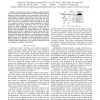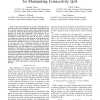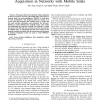35 search results - page 6 / 7 » Time-varying Opportunistic Protocol for maximizing sensor ne... |
JCO
2006
13 years 5 months ago
2006
We study a novel "coverage by directional sensors" problem with tunable orientations on a set of discrete targets. We propose a Maximum Coverage with Minimum Sensors (MCM...
INFOCOM
2010
IEEE
13 years 3 months ago
2010
IEEE
—A SEA Swarm (Sensor Equipped Aquatic Swarm) is a sensor cloud that drifts with water currents and enables 4D (space and time) monitoring of local underwater events such as conta...
MDM
2010
Springer
13 years 7 months ago
2010
Springer
—Given the potential scale on which a Wireless Sensor Network (WSN) can be deployed, multi-hop communication will be a pivotal component of the system. When redundant nodes are d...
TMC
2008
13 years 5 months ago
2008
This paper addresses the problem of data acquisition in ad hoc and sensor networks with mobile sinks and proposes a protocol based on swarm intelligence, SIMPLE, to route data in s...
COMCOM
2004
13 years 5 months ago
2004
The key challenge in the design of a wireless sensor network is maximizing its lifetime. This is a fundamental problem and new protocol engineering principles need to be establish...



